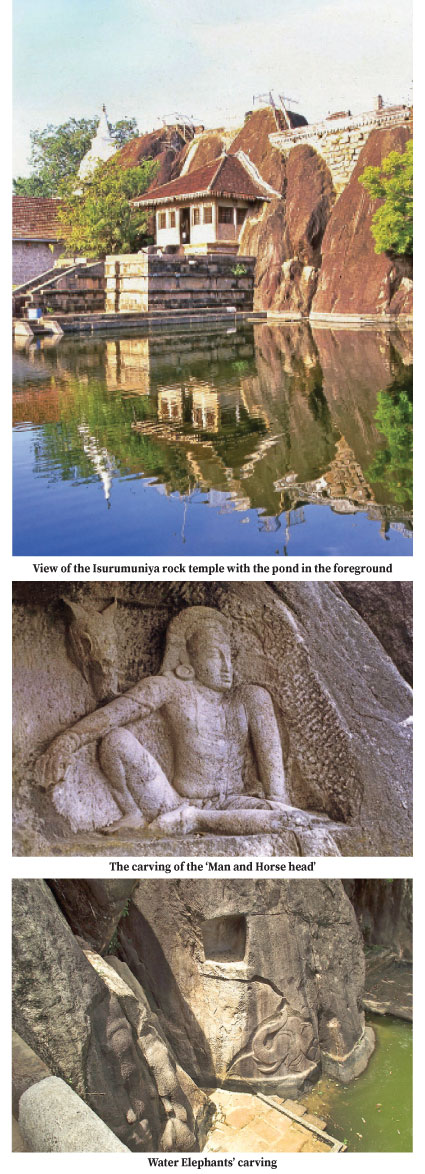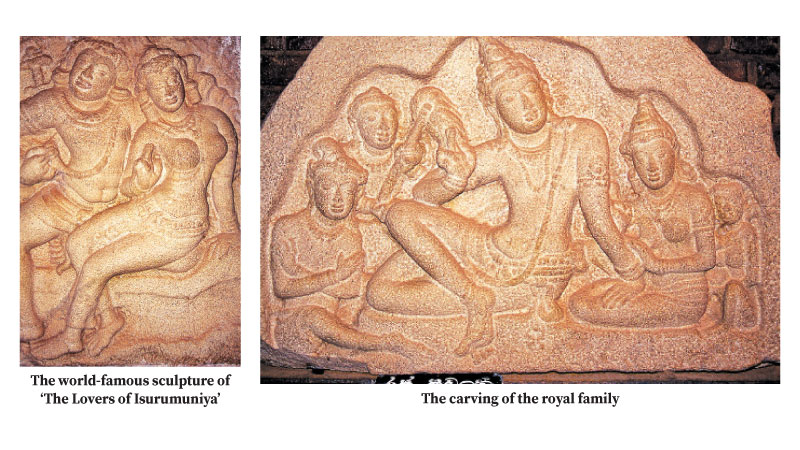 Apart from the ‘Atamasthana’ in the sacred city of Anuradhapura, the city touched by spirituality, there is at least one other temple which is quite interesting from both the historical and artistic point of view. It is the Isurumuniya rock temple which has some unique features compared to other places of worship.
Apart from the ‘Atamasthana’ in the sacred city of Anuradhapura, the city touched by spirituality, there is at least one other temple which is quite interesting from both the historical and artistic point of view. It is the Isurumuniya rock temple which has some unique features compared to other places of worship.
On the east side of the Tissa Wewa embankment, is a rock temple that is renowned for its antique sculptural embellishments. The Isurumuniya Raja Maha Vihara was from huge granite boulders. The main temple is set around a lovely lotus pond, above which there is a black granite surface moulded with figures in bas-relief such as ‘The Water Elephants, and ‘The Man and the Horse’.
Beautified by the pool
From the non-religious point of view, this temple might be the most interesting site in Anuradhapura. Built around two vast boulders below the Tissa Wewa, Isurumuniya is beautified by the pool which is in front of it and embellished by Anuradhapura’s most famous rock carvings.
The open paddy fields around, irrigation channels running through them, the small square pool in the foreground fed from the nearby Tissa Wewa, one of the three largest tanks in the holy city (Nuwarawewa and Basawakkulama are the other two), and a Bo tree overhanging over the water.
Author and archaeologist John Still of ‘Jungle Tide’ fame wrote: “Of all the pretty corners of Anuradhapura, this little group of black rocks is the most picturesque.”
 While the setting of the Isurumuni Vihara dating back to the days of King Devanampiyatissa (3rd Century BCE.) reflects the unspoilt rural environment, it is world famous for two pieces of sculpture – ‘The Lovers’ and ‘The Man and the Horse’. There are also beautiful rock-hewn group of elephants visible on the surface of the rock near the pool.
While the setting of the Isurumuni Vihara dating back to the days of King Devanampiyatissa (3rd Century BCE.) reflects the unspoilt rural environment, it is world famous for two pieces of sculpture – ‘The Lovers’ and ‘The Man and the Horse’. There are also beautiful rock-hewn group of elephants visible on the surface of the rock near the pool.
Many of the sculptures in Isurumuniya are not, in fact religious in nature. The renowned carvings reflect non-Buddhist secular themes and symbols. The sculptural depictions are debatable.
Of the two sculptures, the more popular is ‘The Lovers’ which some interpret as a representation of a Hindu god and his consort – Shiva and Parvati. Former Archaeological Commissioner Prof. Senarath Paranavitana’s contention was that it is Saliya, son of king Dutugemunu and Asokamala, a ‘candala’ maid whom the prince preferred to the throne. Whatever it represents, the bas relief depicts a young warrior on a stone seat with a charming damsel seated on the lap.
‘The Man and the Horse’ is a simple rock-carved figure showing a horse’s head above the shoulder of a man, who, according to some scholars, represents the Hindu saint Kapila. A splendid carving in high relief of a male figure, seated in a relaxed royal pose while the handsome head of his horse peers over his right shoulder. These are described as being of the 7th Century Pallava style of South India.
His left arm stretches vertically down where the hand is placed palm downwards on the base. His right arm is resting on his right leg bent at the knee. The abstracted figure exudes a powerful countenance. When you observe the upper body in detail, there appears to be a ‘Poona Noola’ (A sacred thread which was worn by ancient ascetics) around his neck.
Dr. Ananda Coomaraswamy describes it thus: “The saga is represented as a man of supreme dignity seated in the pose of kingly ease, grazing outward from the cave, as if on the watch for the coming of the sons of Sagara; this outwardly directed interest reminds us that this is the figure of a man, no god, without detracting from its supreme grandeur.”
Dr. Paranavitana identifies the man with the Rain-God Parjanya and the horse as fire. He said that the site was also the place where rain-making ceremonies were carried out.
Rock-hewn elephants
Above the pool, in bas-relief is a disneyesque group of elephants frolicking in the water; the natural shape of the rock creates a three-dimensional effect.
Being at the water’s edge, the rock-hewn elephants are supposed to depict them descending to the pond for water. “The artist has been very successful in rendering the sagacious look of the beast. Rarely has the elephant been represented in art in a manner true to nature than in this relief,” writes Dr. Paranavitana.
Today the Isurumuniya rock temple is visited by thousands of pilgrims and tourists. The temple that leads to a small boulder-top dagaba has a mirador which offers a panoramic view of Anuradhapura. The steps leading to the old shrine room are guarded by two intricately carved ‘Muragal’. The adjoining museum houses artifacts found in the site including the world-famous sculpture of ‘The Lovers’ and ‘Raja Paula’ (The king’s family).









